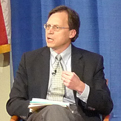The Social Innovation Fund (SIF), an Obama Administration public-private sector initiative launched last year, represents a new way of doing business for the government. Yet like many programs, SIF’s future is in jeopardy until Congress passes the 2011 budget. A bill now before Congress proposes cutting $100 billion from this year’s budget and eliminates the Corporation for National Community Service (CNCS), which houses SIF.
 What great timing for the Stanford Social Innovation Review (SSIR) to hear straight from SIF Director Paul Carttar (left), who we interviewed after his keynote panel discussion at the 2011 Social Enterprise Conference this past weekend. During the keynote and in our interview, Carttar shared some of SIF’s challenges and accomplishments. (Carttar is coauthor of “Zeroing in on Impact,” an oft-cited SSIR article.)
What great timing for the Stanford Social Innovation Review (SSIR) to hear straight from SIF Director Paul Carttar (left), who we interviewed after his keynote panel discussion at the 2011 Social Enterprise Conference this past weekend. During the keynote and in our interview, Carttar shared some of SIF’s challenges and accomplishments. (Carttar is coauthor of “Zeroing in on Impact,” an oft-cited SSIR article.)
Carttar was clear that, as planned, SIF is moving swiftly ahead with its second year of grantmaking, and applications for the coming year are due by April 12. Last year, 54 organizations met the April 2010 deadline for SIF’s inaugural year of grants, and in July, 11 “intermediaries” – grantmakers across the U.S. – were selected to receive a share of $50 million in grants. SIF looked for grantmaking organizations that had strong track records of successfully identifying and growing high-performing nonprofits. In turn, these grantmakers were tasked with identifying on-the-ground, service-providing organizations (subgrantees) that lead social change in youth development, economic opportunity, or health, and that could provide evidence of real impact. A full list of the first year’s subgrantees should be announced by the end of this month, said Carttar.
Last week, SIF posted a PDF with the executive summaries of all 54 qualified applicants. Also available: the full applications of the 11 organizations that received funds. Carttar hopes these documents can be a useful resource for people and organizations interested in SIF and social innovation generally.
Carttar emphasized that SIF grants provide leverage for much greater funding than typical grants, since SIF grants must be matched dollar-for-dollar at both the intermediary and service-providing levels. The match requirement is designed to generate support from a wide variety of partners, all united by the same theory of change. This private-philanthropic support also provides more long-term stability than federal funds. SIF has been authorized for $60 million in appropriations in 2011 – dependent on the outcome of current budget negotiations – and President Obama has put $70 million in the 2012 budget.
Are you enjoying this article? Read more like this, plus SSIR's full archive of content, when you subscribe.
Although future funding for SIF is undeniably at risk, Carttar was emphatic about the impact SIF has already had. “SIF created a vision of leveraging the government’s assets for social change. This is a new way of doing things for the government,” he said. SIF’s focus is on community-based interventions that can prove results with evidence. “The goal is to find the best of these organizations and build them so that they reach as many people as possible,” he said. Read SSIR’s interview with David Gergen in Fall 2008 here.
“In communities throughout the U.S., there are social entrepreneurs who have a passion for solving problems in their communities, and the skills and vision to address those problems. SIF was invented to encourage public-private partnerships to reduce barriers to growth for these organizations that have proof of impact. This emphasis on outcomes and on growing successful models, is a winning idea that’s not going away,” said Carttar. “SIF represents the President’s belief in community-based change, that entrepreneurs have better ideas than bureaucrats,” he noted.
The 2011 Social Enterprise Conference is presented annually by the students of the Harvard Business School and the Harvard Kennedy School. Carttar was joined on stage by Carol Thompson Cole, president and CEO of Venture Philanthropy Partners, which received funding from SIF in 2010. The discussion was moderated by David Gergen, senior political analyst for CNN and director of the Center for Public Leadership at the Harvard Kennedy School. Read SSIR’s interview with David Gergen in Fall 2008 here.
Support SSIR’s coverage of cross-sector solutions to global challenges.
Help us further the reach of innovative ideas. Donate today.
Read more stories by Regina Ridley.

